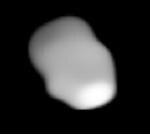Our website is made possible by displaying online advertisements to our visitors.
Please consider supporting us by disabling your ad blocker.
48 Doris
 | |
| Discovery | |
|---|---|
| Discovered by | Hermann Mayer Salomon Goldschmidt |
| Discovery date | 19 September 1857 |
| Designations | |
| (48) Doris | |
| Pronunciation | /ˈdɔːrɪs/[1] |
Named after | Doris |
| Main belt | |
| Adjectives | Dorian /ˈdɔːriən/[2] |
| Orbital characteristics[3] | |
| Epoch 31 December 2006 (JD 2454100.5) | |
| Aphelion | 500.093 Gm (3.343 AU) |
| Perihelion | 430.463 Gm (2.877 AU) |
| 465.278 Gm (3.110 AU) | |
| Eccentricity | 0.075 |
| 2003.453 d (5.49 a) | |
| 336.191° | |
| Inclination | 6.554° |
| 183.754° | |
| 257.583° | |
| Physical characteristics | |
| Dimensions | 278 km × 142 km[4] |
| 215±3 km[5] 221.8±7.5 km (IRAS)[3] | |
| Flattening | 0.28[a] |
| Mass | (6.9±2.9)×1018 kg[5] (12.3±6.0)×1018 kg[b][6] |
Mean density | 1.32±0.55 g/cm3[5] 2.12±1.07 g/cm3[6] |
| 11.89 h[3] | |
| 0.066[5] 0.062[7] | |
| C[3] | |
| 7.14[3] | |
48 Doris is one of the largest main belt asteroids. It was discovered on 19 September 1857 by Hermann Goldschmidt from his balcony in Paris.
To find a name for the object, Jacques Babinet of the Academy of Sciences created a shortlist and asked the geologist Élie de Beaumont to make the selection. De Beaumont chose Doris, after an Oceanid in Greek mythology. Since Doris was discovered on the same night as 49 Pales, de Deaumont suggested naming the two "The Twins".[8]
- ^ "Doris". Merriam-Webster.com Dictionary. Merriam-Webster.
- ^ "Dorian". Oxford English Dictionary (Online ed.). Oxford University Press. (Subscription or participating institution membership required.)
- ^ a b c d e "JPL Small-Body Database Browser: 48 Doris" (2008-06-13 last obs). Retrieved 10 November 2008.
- ^ Cite error: The named reference
RASNZwas invoked but never defined (see the help page). - ^ a b c d e P. Vernazza et al. (2021) VLT/SPHERE imaging survey of the largest main-belt asteroids: Final results and synthesis. Astronomy & Astrophysics 54, A56
- ^ a b Masses and densities of minor planets Archived 2011-06-04 at the Wayback Machine - Yu. Chernetenko, O. Kochetova, and V. Shor
Kochetova (2004) - ^ Asteroid Data Sets Archived 2009-12-17 at the Wayback Machine
- ^ Schmadel, Lutz D. (2003). Dictionary of Minor Planet Names. Springer Science & Business Media. p. 20. ISBN 978-3-540-00238-3.
Cite error: There are <ref group=lower-alpha> tags or {{efn}} templates on this page, but the references will not show without a {{reflist|group=lower-alpha}} template or {{notelist}} template (see the help page).
Previous Page Next Page


